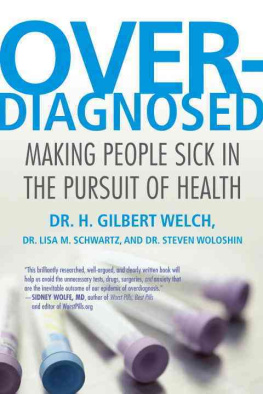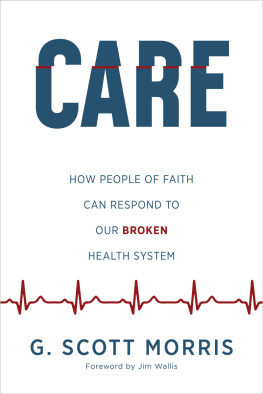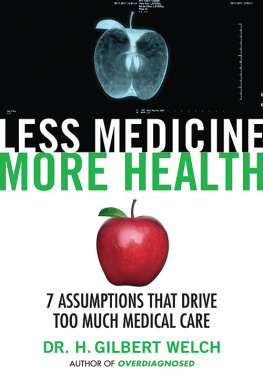Acknowledgments
My mother died just as I was completing this book, hence the dedication to her. But I should also acknowledge her contribution during life. While she was unable to provide any direct input (with the exception of some comic relief) to this book, she certainly laid the groundwork for my writing it. When I was a high school student, no one was harder on my writing than Mom. She made it clear that good writing didnt come easily but was the product of careful thought and constant revision. Perhaps more important, she was equally hard on the medical profession. When I was in college and, later, in medical school, she exposed me to the excesses in medicine she dealt with as member of the states certificate-of-need program and as a hospital trustee during the 1970s (Do we really need two CT scanners in this town?). These influences ultimately set the stage for my writing this book.
While I take responsibility for all the words, I certainly cant take credit for all the ideas. This book would not have been possible without the work of others. I regret that their contribution is only acknowledged in the notes. A few have contributed to not only the underlying science but also the writing itself. My coauthorsLisa Schwartz and Steve Woloshinclearly fit in this category, as they have both performed considerable original research in the area and were involved in writing the entire book. I also want to acknowledge the more focused contributions of my colleagues Bill Black and Wylie Burke, whose research and feedback were invaluable to the sections dealing with radiology (chapters 3 and 7) and genetics (chapter 9).
Ideas and attention to the writing process are necessary ingredients for writing a book, but they are not sufficient. The final prerequisite is time: time to write, and time to think. I am indebted to the Department of Veterans Affairsboth its Health Services Research and Development Service and its local VA hospital in White River Junctionfor supporting the sabbatical during which this book was written and, more broadly, for supporting my work over two decades. I particularly want to thank Gary DeGasta, our recently retired hospital director, who for twenty years acted on his vision of a small rural VA hospital, asking big questions about the U.S. health-care system.
Others also helped make my sabbatical happen. I appreciate the salary support provided by the Helmut Schumann Special Fellowship in Healthful Living, and the collegiality and office space provided by the Montana State University in Bozeman, Montana, and by the Gila Regional Medical Center in Silver City, New Mexico.
Finally, I am indebted to my wife, Linda, for both her tolerance (she has had to listen to some of these ideas ad nauseam) and her ability to give me space (sometimes when Im writing, Im not that fun). Her companionship provided me with the strength to persevere.
H. Gilbert Welch
Thetford, Vermont
Chapter 1: Genesis
People Become Patients with High Blood Pressure
Might as well begin at the beginning. And the beginning of overdiagnosis lies in the diagnosis and treatment of a common conditionhypertension (high blood pressure).
Only one paragraph in and I can already sense the unease in my physician and public health colleagues ( Is he really going to start by suggesting we stop diagnosing hypertension? Were not doing enough to diagnose and treat hypertension now! ). In fact, detecting and treating high blood pressure is one of the most important things we doctors do. And its true that we dont do enough of it. There are some people with undetected hypertension who would benefit tremendously from treatment.
But its also true we do too much of it. Some people are diagnosed and treated needlesslythey are overdiagnosed. Hypertension was arguably the first condition for which regular treatment was started in people without symptoms. Prior to the late twentieth century, physicians generally prescribed medicines only to patients with symptoms of disease. But hypertension changed that. Suddenly people with no health complaintswho perceived no health problemswere being given a diagnosis and prescribed treatment. People became patientsit was really a remarkable paradigm shift. Seeking diagnoses of hypertension in those without symptoms provided the opportunity to prevent symptomatic disease in some, but at the cost of making the diagnosis in others who were not destined ever to develop symptoms or die from hypertension. In other words, at the cost of overdiagnosis.
A condition that warrants treatment
I work at a small Department of Veterans Affairs hospital in White River Junction, Vermont. Earlier in my career, Id spend one or two months a year taking care of patients who were sick enough to be admitted to the hospital. One evening I admitted a fifty-seven-year-old man who came to the emergency room complaining of severe chest pain. Mr. Lemay told me he had been having increasingly frequent episodes of chest pain; sometimes he had the chest pain when he was walking or otherwise exerting himself, and sometimes he had the chest pain when he was doing nothing at all.
The phrase chest pain has almost magical qualities in medicine. It is a powerful catalyst for action; it can trigger a cascade of tests and interventions. That is because chest pain sometimes signals a heart attackthe number-one cause of death in the United States. A patients mere mention of chest pain impels us to do a number of things very quickly, like provide supplemental oxygen, administer an aspirin, and check an electrocardiogram. Mr. Lemays electrocardiogram was markedly abnormal. It showed that part of his heart wasnt getting enough oxygen, a sign of an impending heart attack.
But something else was markedly abnormal. His blood pressure was 202/117. Blood pressure is measured using two numbers. The top number (in this case, 202) is called the systolic blood pressure. It reflects the highest pressure in your arteriesthe pressure created immediately following the contraction of the heart. The bottom number (in this case, 117) is called the diastolic blood pressure. It reflects the lowest pressure in your arteriesthe pressure immediately prior to the contraction of the heartthat is, when your heart is most relaxed. If a doctor is asked, What is a normal blood pressure? shell typically give the numbers 120/80. But doctors see blood pressures higher than this all the time. The question is: At what level is blood pressure abnormal? Most doctors would agree that a systolic pressure over 160 or a diastolic pressure over 90 is abnormally high. And we all would agree that 202/117 is abnormally high. Really high. In factreally, really high.
Because an impending heart attack was a genuine concern, I admitted Mr. Lemay to the intensive care unit. We gave him medicines to lower his blood pressure, and his chest pain quickly went away. He did not have a heart attack. Well, maybe by todays standards he did. This was in the early 1990s, before we routinely checked troponin levels (a very sensitive indicator of heart damage). Then we made the diagnosis by combining electrocardiogram findings with relatively crude laboratory measurements. My guess is that today we would diagnose Mr. Lemay as having had a small heart attacka subendocardial myocardial infarction. But all the same, a couple of days later, he went home. That was over fifteen years ago. And he has not been in the hospital since.
Mr. Lemay is now seventy-two. I see him in clinic about twice a year. Hes been very healthy. Ive done very little for him, except one thing: Ive made sure his blood pressure is controlled. Its not glamorous. Its not difficult. It certainly doesnt require a physician (nurses, nurse-practitioners, and physician assistants can do it just as well). But for patients like Mr. Lemay, its pretty close to being the difference between life and death. While one can never be sure, I am confident that he would have died years ago had his hypertension not been diagnosed and adequately treated. Of course, he came to the emergency room not for the high blood pressure but for the chest pain it caused. But even if he had had no symptoms, simply a sustained blood pressure of 202/117, I would say that treatment saved his life. Let me tell you why I can confidently say that.
Next page






